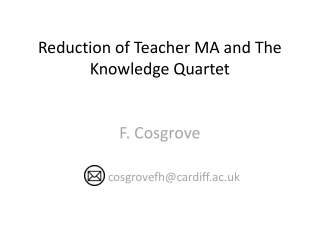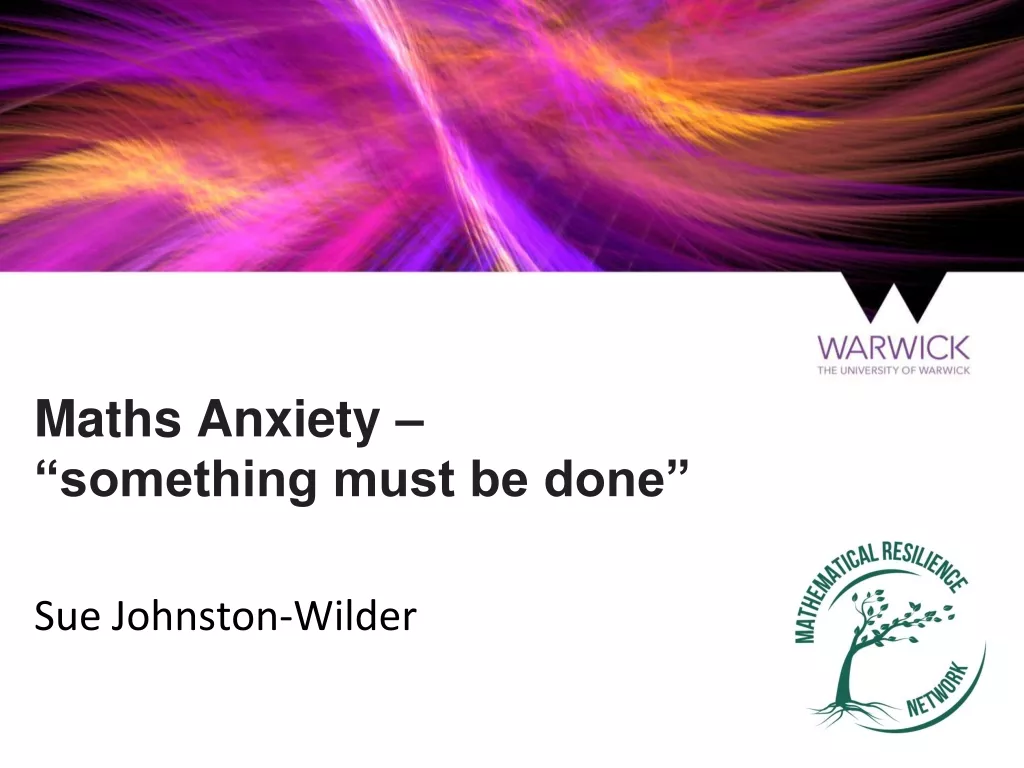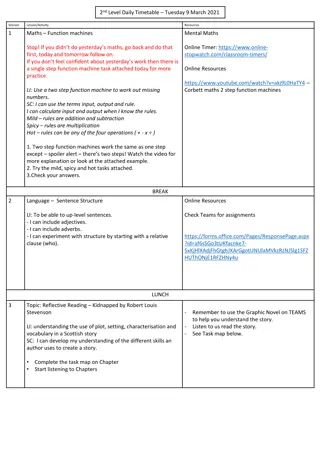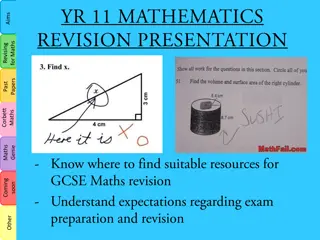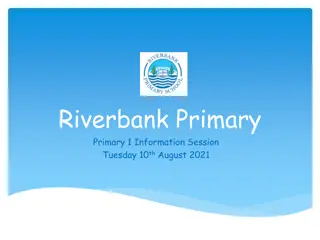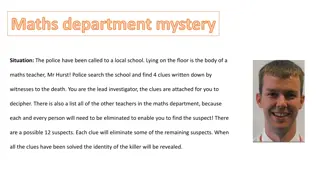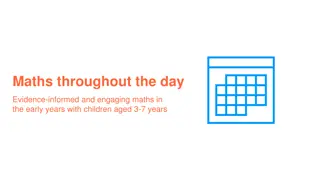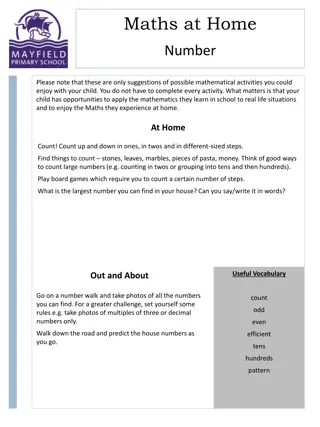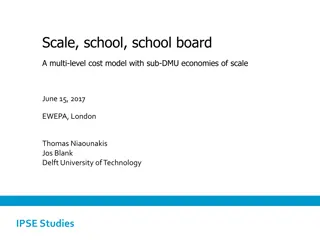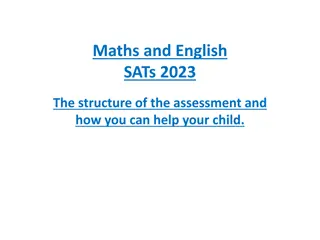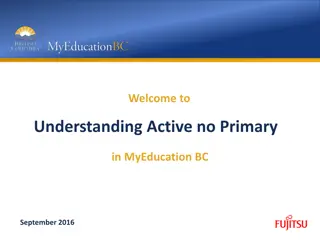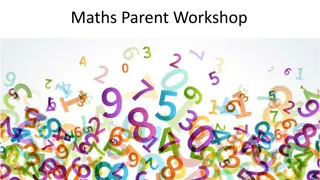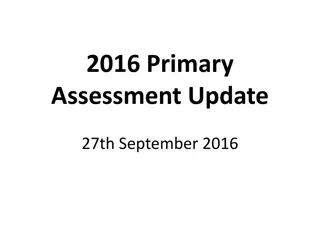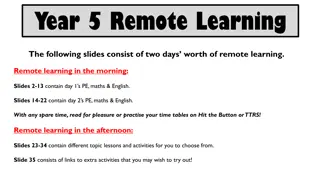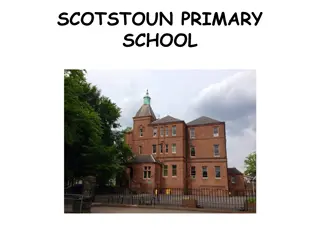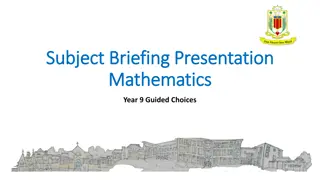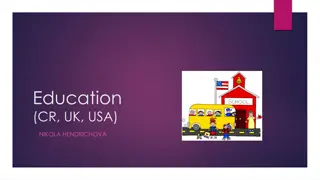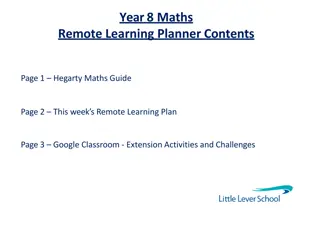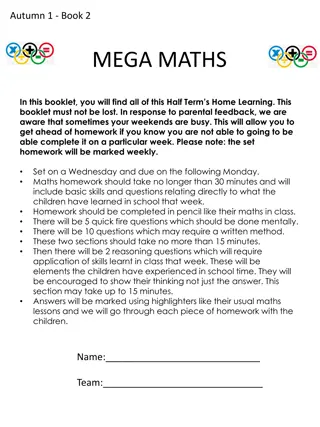Exploring the Importance of Maths Education at Brough Primary School
Delve into the world of mathematics education at Brough Primary School through a Y5/6 Maths workshop. Discover how Maths is taught using the Concrete Pictorial Abstract approach and learn why this method is crucial for understanding mathematical concepts. Uncover insightful facts about the significance of numeracy skills in today's society and how adults with basic numeracy skills have better job prospects. Explore how children can be supported in learning Maths at home and why a solid foundation in math is essential for future success.
- Maths education
- Brough Primary School
- Concrete Pictorial Abstract
- Numeracy skills
- Importance of Math
Download Presentation

Please find below an Image/Link to download the presentation.
The content on the website is provided AS IS for your information and personal use only. It may not be sold, licensed, or shared on other websites without obtaining consent from the author. Download presentation by click this link. If you encounter any issues during the download, it is possible that the publisher has removed the file from their server.
E N D
Presentation Transcript
Brough Primary School Maths workshop - Y5/6 Tuesday 7th November 2023
Session Aims What does Maths look like in Year 5 and Year 6? How can children be supported at home?
On a scale of one to ten, how much do you honestly enjoy Maths?
Research suggests that as many as 60% of adults would rather clean the toilet than work out a maths problem! An even larger percentage say: I was never any good at Maths.
A few facts as to why Maths is so important Almost half of the working-age population of England have numeracy skills equivalent to those expected for an 11 year-old child. Adults with poor numeracy skills are twice as likely to be unemployed than those who enjoy some competency in numeracy. Those adults with at least basic numeracy skills can expect to earn a quarter more than those who lack the necessary skills to solve basic mathematical problems.
How is Maths taught at Brough Primary School?
C CPA Approach: Concrete Pictorial Abstract Concrete: 'doing' the maths- introducing real objects that can be manipulated to bring the problem to life. Eg: money, counters. Pictorial: 'seeing the maths'- making connections between the concrete and the pictorial representations and the pictorial and the abstract. Eg: part whole models, bar models, ten frames. Abstract: the ultimate goal is for children to understand abstract mathematical concepts, signs and notation. When a child demonstrates with concrete models and pictorial representations that they have grasped a concept, we can be confident that they are ready to explore the abstract.
Why is C-P-A so important? In the past, children were taught procedures, but not why or how the procedure worked. In other words, children learnt the methods to get to an answer, without any understanding of the maths behind each method or procedure. While there are children who are able to access the maths through just learning a procedure by rote, many others have great difficulty coping with the abstract nature of it. Teaching methods without meaning leads to misconceptions, errors and difficulties in retaining the methods. Once children can actually see the maths, they are much more likely to understand and accurately remember the methods.
Manipulatives used in class to support learning Manipulatives used in class to support learning Part whole model Bar model Ten frames Bead strings cubes Numicon
Number lines Base 10 Number tracks Place value counters
Fluency, reasoning and problem solving skills Fluency, reasoning and problem solving skills What is problem solving? What is problem solving? Problem solving is applying the mathematics children have learnt to solve problems. If children are fluent in the mathematical procedures required for each topic, problem solving becomes much easier. When approaching problems, children must first work out what the problem is asking them to do, before then applying their procedural knowledge to find a solution. What is fluency? What is fluency? Fluency starts with the ability to apply procedures accurately and efficiently. This means that children quickly become confident in the methods they will later need to use to solve more complex problems. What is reasoning? What is reasoning? Reasoning enables children to make use of all their other mathematical skills; it could be described as the glue that helps mathematics make sense. Reasoning is children understanding mathematics well enough that they can apply it to new situations and explain it.
NATIONAL CURRICULUM AIMS FOR CHILDREN What does Maths look like for children in Years 5 and 6? National Curriculum Programmes of Study for Key Stage 1 and Key Stage 2
What does Maths look like in Year 5? Measure angles in degrees ( ) and draw angles of a given size. Recognise the place value of each digit in numbers with up to 2 decimal places To use the formal written methods for all four operations (addition, subtraction, division and multiplication) Secure understanding of fractions including simplifying, equivalent fractions and calculating with fractions (+ - and x by integers) Rapid and accurate recall of ALL times tables and related division facts To solve number problems using reasoning to justify my answers and to prove and disprove. Find non- unit fractions of quantities. Convert between units of measure e.g. grams to kilograms Draw upon a variety of mental maths strategies to support arithmetic skills
What does Maths look like in Year 6? accurate recall of ALL times tables according to given properties, including dimensions, angles and area Find Rapid and equivalent fractions, decimals and percentages Draw, compose and decompose shapes Solve problems involving ratio relationships Recognise the place value of each digit in numbers up to 10 million, including decimal fractions Draw upon a variety of mental maths strategies to support arithmetic skills Systematic and methodical workings Solve multi- step word problems To consolidate the formal written methods and use alongside efficient mental strategies Use common factors and multiples to simplify fractions. To securely use all four operations when calculating with fractions (+ - x ) Algebra Working with numbers beyond 6 and 7 digits
What do you have to know to be able to solve this problem? Imagine if you did not have those skills or strategies .. How hard would it have been to solve those questions. Importantly, in preparation for not only their SATs but for their Secondary School education, it is important that children know by heart:
Times tables and their related division facts. This will help your child to solve problems that involve Long multiplication Fractions Percentages
Children need to be able to
Percentages Talk about how percent means number of parts per hundred . Talk about numbers that are represented in percentages. For example, you could work out what proportion of your child s class at school are girls. Ask them to tell you how to represent the percentage as a fraction and decimal (for example, 55% = 55/100 = 0.55). Sales at the shops can provide great real-life opportunities to work with percentages. For example, you could ask your child to help you work out the sale price of an item. If there is 30% off a T-shirt and the full price is 9.99, what is 30% of the full price and what is the sale price?
How can you help your child at home?
The times tables are the basics of maths. If you know the basics, you ll find the rest much much easier. @TTRockStars ttrockstars.com
All of the Maths concepts in the Maths cloud are taken from the GCSE curriculum and use times tables knowledge! @TTRockStars ttrockstars.com
We recommend a little and often approach; 5 minutes practice a day, 4 or 5 times a week is a good target
Times Table Rock Stars!
Checking your childs progress Checking your child s progress is easy: When your child has logged in, select their avatar in the top right hand corner and then select the My Stats option. In the effort tab, you can see how many minutes the children have played. Under fluency, you can see how quickly your child is able to answer each question and how confident they are with their individual times table knowledge. https://www.youtube.com/watch?v=phxP5_OhOt k ?
A quick guide to everyday Maths opportunities for your child Practise spotting and recognising numbers in the environment. Add/multiply/subtract/divide door numbers, numbers on car registration plates, road signs and at the shop. Flicking through the TV guide? Ask your child to calculate the length of their favourite programmes. How long is it until the next programme? Use food packaging to discuss 2D and 3D shapes. What are the properties of these shapes e.g. how many faces, sides, vertices? Flatten the packaging out to find the net of the 3D shape too. Measuring up for new furniture? Want to make sure the Christmas tree will fit in your living room? These are really good opportunities to encourage your child to see the value of careful measuring skills in everyday life. Practise telling the time with your child. Can they read both the digital and analogue clock? Can they readily convert between the two and use the 24 hour clock? Can they also recognise Roman Numeral representations of the time too? Board Games supply endless opportunities for Maths Snakes and Ladders, Monopoly, Bingo, Connect Four, Battle Ships etc
Navigating our school website We have a number of resources available for you to use with your children to support their Maths learning or to guide your own understanding of the Maths curriculum. Key Areas covered: curriculum statement. long term plans. Progression of skills. parents information evening - calculator policies. Ultimate Maths Vocabulary List. Maths with Michael videos and fact sheets - place value, subtraction, multiplication, division, fractions, algebra.
Navigating our school website https://broughprimaryschool.co.uk/ curriculum - subject areas - Maths
Children benefitting from learning in a sensory way What I hear, I forget; What I see, I remember; What I do, I understand. (Old Chinese proverb)
So lets do.. Some simple dice games: 1.Build it big. 2.Roll it and round. 3.Improper fraction challenge. 4.Area and perimeter.
Some simple card games Race to 100. Go Fish. Calculate loss or gain. Card turnover and multiply. Declare a fraction war I spy. BODMAS to get 24. Take a trip around a card.
Build it big You need to make dashes on your paper/whiteboard to indicate the place value of the number. So, if you re working on hundreds, make 3 dashes, 4 for thousands, and so on. Take turns rolling dice the same number of times as the dashes. Each time a person rolls, he/she must think logically to place the number shown on the dice, on the dashes. For example, if you are working on a large number and roll a six, it would go on the largest place value space but if you were working on making a small number, it would go on the smallest place value space. Once you have placed a number, it can not be moved. The person with the highest (or lowest, depending upon the game s goal) wins a point. You could also use decimal points. Roll and round The first person rolls all three dice at the same time and builds a number with it. The second person does the same and then each person rounds his/her number to the highest place value. For example, a roll of 5, 3, 7 could make the number 753, which would be rounded to 800. Compare rounded numbers and the highest correctly rounded number wins . You could also use decimal points, positive or negative numbers.
Improper fraction challenge Each person rolls the 3 dice and makes an improper fraction by placing two of the dice side by side as the numerator and the other dice as the denominator, and then simplifies to make a whole number or a mixed number. For example, if someone rolled 2, 4, 5 some possible fractions would be 24/5 = 4 4/5 or 54/2 = 27 or 45/2 = 22 1/2. The higher-level thinking comes in as trying to make the largest number possible. Area and perimeter Each person rolls the dice and uses the numbers as the length and width of a rectangle. Once area (or perimeter) has been determined, keep a running total of points. For example, if the area was ten and the second area was 6, the running total would be 16. Highest score at the end wins.
Some simple card games Race to 100 Flip a card and add its value to your running total. First person to reach 100 without going over wins! (Remove face cards for younger players; use these values for older kids: Jack = 11, Queen = 12, King = 13, Ace = 0.) Go fish Go Fish, but in this version, you re fishing for pairs that add up to 10. Ask: I have a 2. Do you have an 8 to make 10? Change aces to 1 for this game and leave face cards out entirely. Calculate loss or gain Each player starts with 15 points. Player one flips a card (remove face cards or assign them point values first). If the card is black, they add it to their total. If it s red, they subtract it. Highest point total when all the cards are gone wins!
Card turnover and multiply One person flips two cards from the deck. The first person to multiply (or add, depending on what you want to practice) them correctly and call out the answer wins and takes both cards. Play continues until all the cards are gone, and the winner is the one with the most cards. Declare a fraction war Deal two cards a numerator and denominator then determine whose fraction is the largest. The winner keeps all four cards, and play continues until the cards are gone. I spy Lay out cards on the table, then take turns giving clues. I spy two cards that add up to 12. Differentiate for younger children with options like, I spy a card that s less than 4, or for older ones: I spy two cards that are factors of 12.
BODMAS to get 24 Each player is dealt four cards, then uses the order-of-operations rules to try to make a number as close to 24 as possible. Take a trip around a card You ll need a pair of dice for this math card game. Lay out cards randomly in a spiral formation as shown, and set a marker for each player on the center card. Player one rolls the dice then moves their piece that number of spaces shown. They then must multiply (or add or subtract, depending on preferences) the card number by the number on the dice. If they get the answer correct, they stay where they are. If not, they return to their original card. Play continues until one player reaches the end.
Websites to support children s Maths skills I See Maths a useful site with a plethora of ideas for fun games that all the family Primary Games - It is a free website that encourages children to play online maths games linked to their home learning. It breaks the games down into concepts which is really helpful. Hit the Button children love this game as it helps to increase confidence through practising times tables and number bonds. Maths Zone this site is jam-packed with fun ways to learn more about maths. BBC Bitesize lots of information alongside short videos help to make the learning enjoyable and accessible for all children. Top Marks - a variety of Maths games linked to different aspects of Maths.
Thank you for coming. Any questions?


